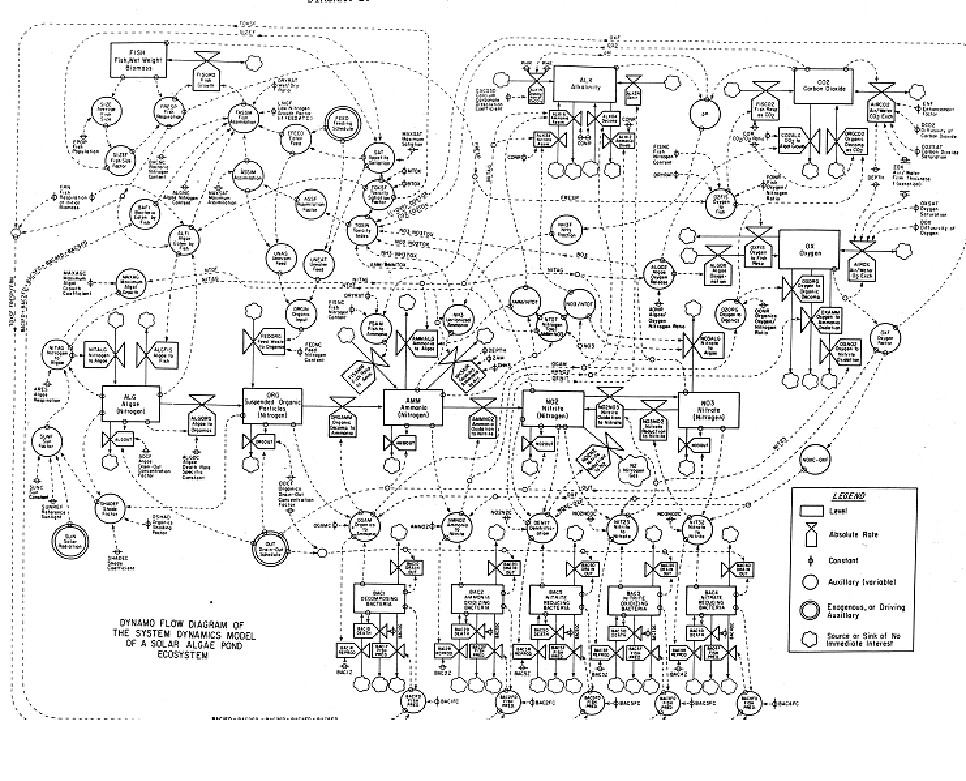Solar Aquaculture
Aquatic Alchemy
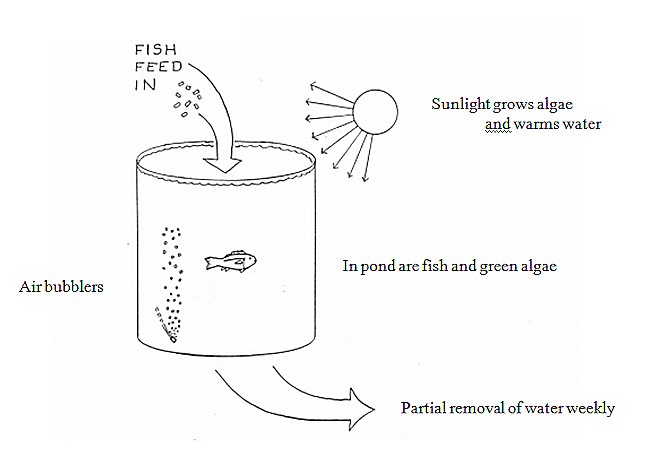
From 1971 to 1991 New Alchemy Institute researched the idea of growing edible fish on a household scale. The goal was to grow high-quality fish protein in a small, clean, controllable pond, using home-scale technology and minimum fossil fuels. After many years’ inspired trial and error, backed up by meticulous science, there emerged techniques for fish culture in what New Alchemy called solar ponds- large cylinders of water for growing edible fish.
A standard New Alchemy solar pond is a 5’ high, 5’ diameter, translucent fiberglass cylinder that contains about 700 gallons of water. Typically each pond contains 10-20 pounds of fish that are fed daily at an optimum rate of 3 % of their body weight. Managed for high production, such a pond can produce an annual growth of 40 pounds of fish. The he solar pond should be located in full sunlight and has air bubblers continuously aerating it. Good management also includes removing 20 % of its water each week, and then refilling with 20 % fresh water.
The biology and chemistry in the solar pond changes constantly. Each day the fish in the pond are fed. Some of the eaten food is absorbed as the fish grows, and some of it becomes wastes that mix in the water. Microscopic green algae live in the pond with the fish, and as they grow they absorb nutrients from the water. Each day sunlight strikes the pond, entering the water and helping the algae grow. Sunlight also causes the water to get warmer. Fish generally grow faster in warmer water.
Solar Ponds For Solar Heat Storage in Buildings
A solar pond can serve two purposes in a building or greenhouse – fish culture and storage of solar heat. Sunlight that strikes a solar pond enters the water and is initially absorbed by the dense, green algae in the water. As growing plants, the algae can capture about 5 % of the solar energy. The other 95 % of the solar energy becomes heat and makes the pond water warmer.
During each sunny day, the water in a solar pond warms up and stores heat. Each night the pond cools down as some of that heat is released into the air and is radiated to nearby objects. This storage and release moderates the extreme high and low temperataures in the greenhouse. Because some of the incoming sunlight is stored as warm water rather than hot air, the air is cooler during the day. Because the solar ponds release heat at nigh, the air is warmer during the night.
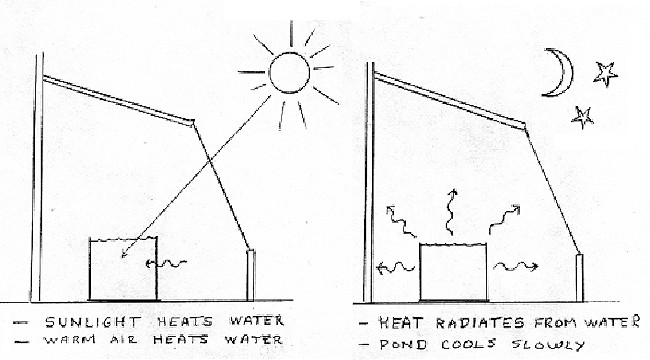
Solar heat storage and release in solar ponds is automatic. It occurs due to passive, natural movement of light, warm water and warm air. It does not require pumps or fans or controls. A solar pond can store an enormous amount of heat. It can sometimes provide useful heat for several nights in row as it slowly cools.
Solar heat from a solar pond can substitute for heating a greenhouse with gas, oil or wood or electricity. In mild temperate climates, solar ponds can largely eliminate the need to burn fossil fuel for heat. In the Cape Cod Ark, for example, in a region with many sunny winter days, the daytime temperatures are often tropical and the lowest night-time temperatures only occasionally approach freezing. The plants grow actively during the warm days and slow down each night.
In computer simulations of dome greenhouses, the presence of solar ponds as thermal mass reduces the average daily temperature swings by 10 degrees F, and raises the monthly minimum temperatures by 6-8 degrees F.
Understanding the Biology and Chemistry of Solar Aquaculture
For aquaculture research, solar ponds can be treated like very large test tubes. Two solar ponds can be placed side by side and tested against each other by treating one different than the other. Or 10 solar ponds can be tested at once, with 10 different treatments. The biological activity in each one will be different than the others,and the fish will be observed to grow faster or more efficiently in one than another.
From 1974 to 1986, New Alchemy used this test tube approach with the aim of learning how to grow fish for human food. Experiments were done with different kinds of fish, numbers and sizes of fish, types of fish feeds, rates of feeding, methods of aerating, amounts of reflected sunlight,and a myriad other factors,
The simplest variables to test are the fish In the pond (type, size, number), and the kinds and amounts of fish food fed to the fish. Other variables that can be controlled are rates of aeration, rates of harvest of fish, and periodic adding of fresh water. Other important variables are not so easy to control, such as the amount of sunlight each day. The aquatic ecosystem in a solar pond is greatly affected by sunlight. With more sunlight, the water gets warmer, biological activity increases, the algae make more oxygen and take up more carbon dioxide, and the water chemistry changes. All these things affect how well the fish grow.
Over a 24 hour period. the effects of sunlight on a solar pond reveals a daily cycle of warming and cooling and changes in oxygen land pH levels of the water. Sunny days show different patterns than cloudy days. And the fish grow at different rates, depending on their temperature and water chemistry.
Using Computer Models To Study Aquaculture
After years of careful observation, analysis, and diligent precise measurements, New Alchemy’s aquaculturalists gained a detailed understanding of the processes in a solar pond.But the processes are astonishingly complex, and often involve a web of non-linear interactions that are too complex for a person’s brain to calculate or predict.
So to refine their understanding of the thermodynamics and bioshemistry of the solar ponds, New Alchemy’s researchers constructed a mathematical model of the interactions within a solar pond. The value of a modeling approach is that, if one can craft a model that is accurate in its rates and interactions, the model can be used in predictive ways to test how well a future pond might do if managed in a particular way.
They started with a simple model of the most obvious patterns of cause and effect. For example – adding fish food caused the fish to grow, but gradually accumulated wastes that slowed the growth down. Each cause and effect Was entered into the model as a mathematical rate, that changed as temperature or oxygen or light levels changed.
The model was gradually improved and made more detailed, and was tested against realityby entering data from real solar ponds to see if the model was accurate enough to reproduce what actually happened.
Eventually the computer model was made good enough to accurately simulate the workings of real solar ponds. A hypothetical solar pond could be was started with a certain number of fish, fed daily with a certain amount of fish feed, aerated at a certain rate, and impacted by typical patterns of sunlight and temperatures.
The model could be set to run to simulate several months of time to see how well the fish would grow, and whether any bad conditions would develop. The computer model’s virtual pond was found to closely resemble what actually happened to a real pond under the same conditions.
A Mathematical Model of Aquatic Reality
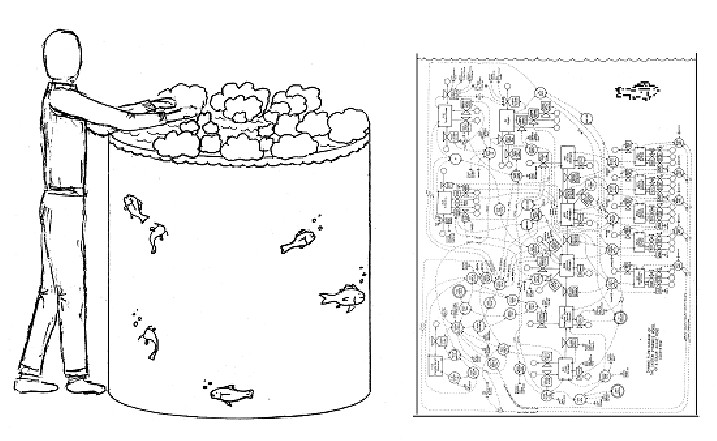
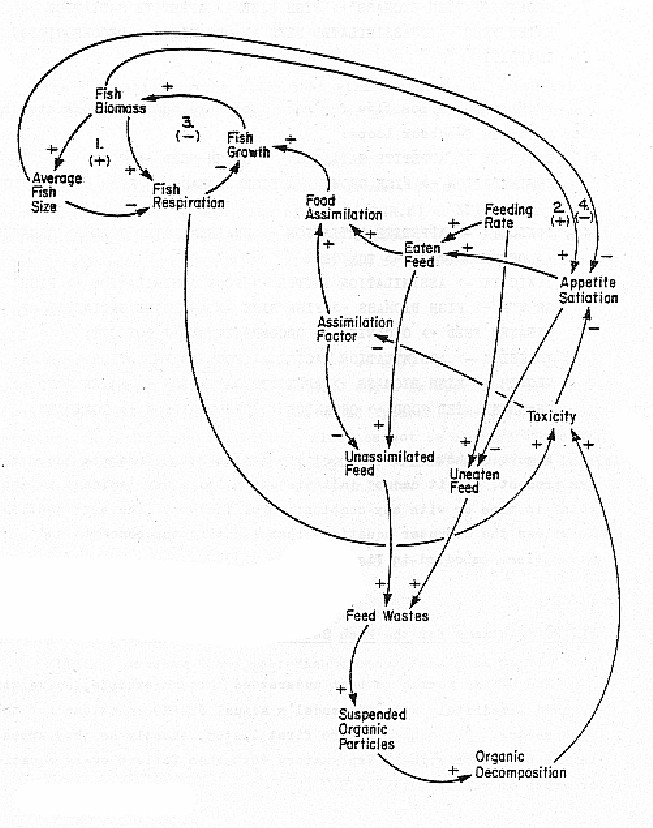
Hydroponics in Solar Ponds – The Zweig Pond
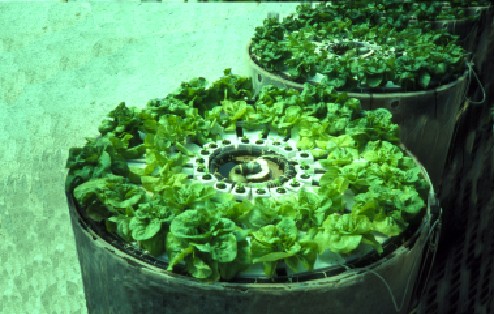
The most sophisticated version of aquaculture using solar ponds is the hydroponic solar pond, developed and refined by Ron Zweig. A Zweig pond is a solar pond with fish growing in the water and hydroponic lettuce growing floating on the surface. The fish are fed, and the lettuce plants get their nutrients from the fertile water of the fish pond. By removing waste nutrients from the water, the lettuce help purify the water and promote better growth of the fish.
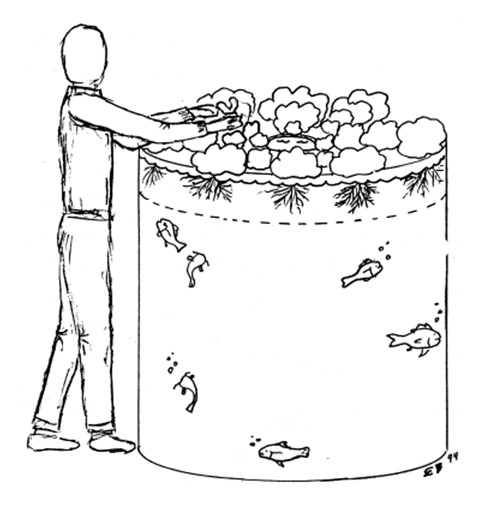 The Zweig pond is that it produces lettuce continuously, in addition to periodic harvests of edible fish.
The Zweig pond is that it produces lettuce continuously, in addition to periodic harvests of edible fish.
The lettuce roots are protected from being eaten by the fish by plastic mesh that separates them. Small lettuce plants are started in the center of the pond arand are moved outward toward the edge as they grow larger. The lettuce is harvested from the sixteen lettuce plants growing around the top of the solar pond.
Tests were carried out using both tilapia and yellow bullhead catfish in the hydroponic solar pond system. Catfish can tolerate much lower temperatures than tilapia, and, young catfish can be obtained more easily than young tilapia.especially in smaller household quantities.


